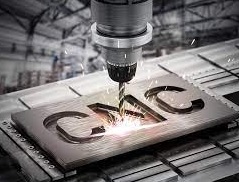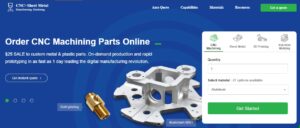 Hello, readers welcome to the new post. Today we will discuss How CNC Machining works. CNC stands for Computer numerical control and type of manufacturing process that give instruction for the working of instruments and equipment through a programmed computer. This process can regulate numerous complex machines like CNC milling machines, CNC lasers, CNC lathes, Waterjet machines electric discharge machines to perform the 3D operations
Hello, readers welcome to the new post. Today we will discuss How CNC Machining works. CNC stands for Computer numerical control and type of manufacturing process that give instruction for the working of instruments and equipment through a programmed computer. This process can regulate numerous complex machines like CNC milling machines, CNC lasers, CNC lathes, Waterjet machines electric discharge machines to perform the 3D operations
CNC provides enhanced productivity than non-computerized techniques for repetitive production, which operates machines manually or mechanically through pre-fabricated pattern instruction. In this post, we will have a detailed overview of CNC machining and also learn how can get CNC services from the best PCB supplier PCBWAY. So let’s get started
How CNC Machining Works
- When the CNC system is activated product file will be programmed in the software and assigned to the resultant tools and machines. The instruments and machines will do certain cutting operations. The CNC machine process is performed through some stages that are listed
- Designing of CAD Modle
- Convert CAD file into CNC program
- Make CNC machines and tools
- CNC Machining operations
Main Processes Of CNC Machining
CNC milling:
- There is the use of multiple-point rotating instruments to eliminate material through the workpiece. Basic mills have a three-axis system that is still one of the most commonly and widely used machine process. In three-dimensional machining, the working piece is constant, and rotating tools cuts along X, Y, and Z axes. Mostly new mills can handle two extra axes four-axis CNC machining and five-axis CNC machining provides versatile operation and can use in the manufacturing of high-accuracy parts.
CNC Turning:
- There are single-point cutting instruments used to remove material from the rotating working piece. In CNC turning CNC machine normally a lathe or turning machine, feeds cutting instruments in linear motion across the surface of the rotating workpiece Eliminate material across the circumference until the required diameter is obtained. Most CNC lathe consists of 2 axis X and Z

Advantages of CNC Machining
Fast and Repeatable Process
- A rapid removal of large amounts of metal material, parts ready in as little as 1 day
Accuracy
- Highly accurate tolerances ranging from +/-0.005″ – 0.01″, depending on customer specifications.
Wide Range of Materials
- There is more than fifty plastic and metallic materials can be used
Scalable Volume
- CNC Machining has scalable volumes for the manufacturing of 1 to 100,000 parts.
Custom Surface Finishes
- Suitable for many different kinds of substrates to make your parts the same as the real products
Cost Saving
- Low investment in tooling and preparation costs, economical for parts with simple construction.
CNC Machining Drawbacks
Structure Limits
- The interlocking and hollow structure is difficult to the CNC machine
Scale Effect
- Unit cost and lead time will not be reduced as much as injection molded parts.
PCBWAY CNC Machining Processes

- PCBWAY provides the Machined metal and plastic prototypes and production parts in as little as 2 days
CNC Milling Service
- From prototyping to full production. Our 3-axis, 3+2-axis, and full 5-axis milling centers allow you to produce highly accurate and high-quality parts that meet even your most stringent requirements.
5-Axis CNC Machine
- Five-axis CNC machine makes parts having complicated geometry and enhances production by decreasing the machine’s setups.

CNC Turning
- CNC lathes are able to provide inexpensive parts for simple cylindrical geometries. Live tools are available for more complex geometries and are considered on a case-by-case basis.
PCBWAY CNC materials
- Commonly used materials for CNC at PCBWAY are listed here
Metal
- Aluminum (4 types)
- Stainless steel (5 types)
- Brass (1 types)
- Copper (1 types)
- Titanium (1 types)
- Mild steel (3 types)
- Alloy steel (3 types)
- Tool steel (6 types)
- Spring steel (1 types)
Plastic
- ABS (3 types)
- Polycarbonate (PC) (1 types)
- Nylon (2 types)
- Polypropylene (PP) (1 types)
- POM (1 types)
- PTFE (Teflon) (1 types)
- PMMA (Acrylic) (1 types)
- Polyethylene (PE) (1 types)
- PEEK (1 types)
- Bakelite (1 types)
- FR4 (1 types)
- Rubber (1 types)
Custom Sourced Materials
- Different types of CNC machined metals and plastic parts configurations are used at PCBWAY instant online quote. If you can not see the material stock you are seeing please choose a custom option in the material drop-down on your quote page and submit for an expert engineering review when specified features, tolerance, inspection required and quantity need
CNC Finishes
- Standard (As-Milled) (Ra 125μin)
- Bead blast + Anodized color
- Anodized
- Electrically conductive oxidation
- Black oxide
- Brushed
- Bead Blast
- Spray painting – Matt paint
- Spray painting – High gloss paint
- Powder Coat
- Chrome plating
- Galvanization
- Nickel plating
- Silver plating
- Gold plating
- Tin plating
- Vacuum plating – High gloss paint
- Vacuum plating – Matt paint
- #1000 sanding
- Silkscreen
- Laser engraving
- Smooth machining (Ra1.6µm, 63 µin)
- Chemical conversion coat (Chem film)
- Electrophoresis
- Passivation
- Etching
- Electropolished (Ra0.8µm, 32µin)
- PVD (Physical Vapor Deposition)
- Pickling
- Others
- Dyeing
CNC orientation and form general tolerances
- Unless they have agreed to other tolerances in your quotation, they will work to achieve and maintain the tolerances below, which will vary according to the primary manufacturing method you choose. (eg: Round hole 10mm, tolerance +0.01-0.03mm)
| Part Length | Orientation and Form Tolerance | Angularity Tolerance |
|---|---|---|
| 0 to 12″(300 mm) | +/- 0.005″ (0.125 mm) | Angularity +/- ½ degree |
| 12″ to 24″(600 mm) | +/- 0.010″ (0.250 mm) | Angularity +/- ½ degree |
| 24″ – 36″(900 mm) | +/- 1/64″ (0.016″)(0.400 mm) | Angularity +/- 1 degree |
| 36″ – 60″(1500 mm) | +/- 1/32″ (0.031″) | Angularity +/- 1 degree |
| Over 60″ | +/- 1/16″ (0.063″) | Angularity +/- 1 degree |
CNC machining Size limitations
| Product | Part size/dimension |
|---|---|
| Maximal part size | 1000 mm (40in) |
| Minimal part size | 2 mm (0.08 in) |
| Minimal diameter | 0.3 mm (0.01 in) |
CNC Ordering Process | PCBWay
- Till now you have gotten a detailed overview of CNC machining now we learn how can get CNC services from PCBWAY
- With different services like PCB manufacturing, PCBWAY also provides CNC Machining, 3D printing, sheet metal fabrication injection molding, and vacuum casting services. To get CNC service from PCBWAY move to their site and press on the “CNC/3D printing” section there are 5 quote pages exist there. The ordering process of five services is generally similar with some different selected parameters. Let now discuss the details of the ordering process of CNC machining from PCBWAY.
- Now let’s get started! https://www.pcbway.com/rapid-prototyping/manufacture/?reffercode=H
Upload CAD Files
- In the case of each CNC order, the first step is to upload CAD files. PCBWAY supported 5 categories of file formats (*.step, *.stp, *.x_t , *.iges, *.sldprt) and you can upload files up to 12 at one time. If the number of files is larger than twelve, need to submit the first twelve quotations and upload the remaining files later. During uploading files notes below can provides some instructions.
Choose Charatericstic of Parts
- The first parameter you need to select is the quantity, When you set the quantity then you can get the per-unit prices to decrement with increments in quantity. To fulfill the different material needs, PCBWAY provides nineteen types of materials and beyond these options, you can also set your custom materials. Every selected material has an online sample and text description and you can press on the “material data sheet” to find a detailed overview.
- The material chosen by you is linked to the surface finish option. For example, Aluminum has about twenty-eight types of surface finish options then Rubber has only eight.
- When you select the surface finish for your desing do not forget to press the “Discrepancy warning” to learn about the PCBWAY additional claims for surface treatment
Submit the Request and Make the Payment
- Once the file has been uploaded and all parameters have been set, you will be provided with an estimated quote and approximate delivery date on the quote page. You can then submit your request and wait for your review. After the review is approved, you can proceed with the payment with the final price.
Here is the video uploaded that can helps you to place a CNC order at PCBWAY.






